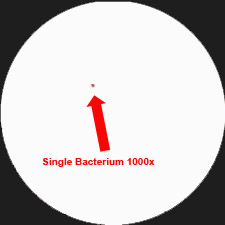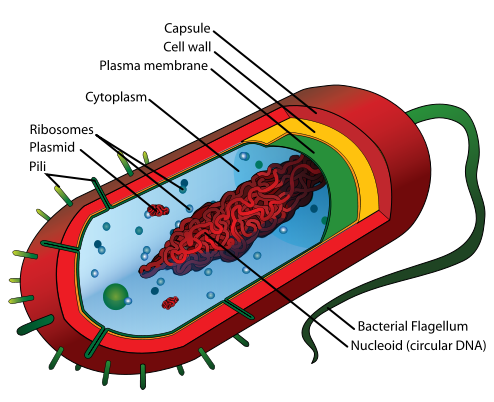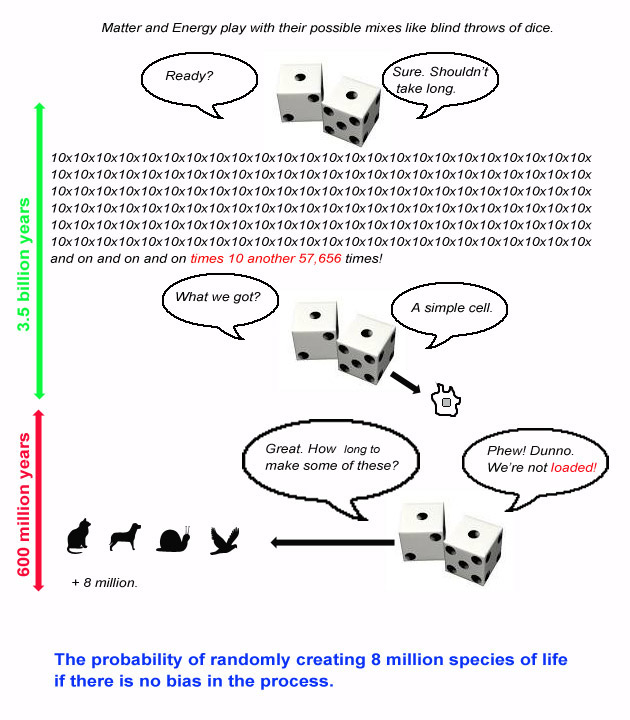|
Biodiversity & Evolution
Scientific theories dictate that Biodiversity is the result of 3.5 billion years of evolution. The origin of life has not been definitely established by science, however some evidence suggests that life may already have been well-established only a few hundred million years after the formation of the Earth. Until approximately 600 million years ago, all
life consisted of archaea, bacteria, protozoans and similar single-celled organisms.
Um... evolution seems to be the cause then. Now, I have to admit that when I look down my microscope at a single bacterium, and this is what I see...
| |

|
|
...and given that a single bacterium is made up from 139 kbp to 13,000 kbp. (Kilo Base Pairs) and that a human being consists of 3 billion base pairs organized into 23 paired chromosomes, it seems highly unlikely I evolved from that little dot, despite the possible 600 million years of mutation which evolution insists occurs to make that happen since first bacteria to living me.
It appears even more profound to me that the little dot, with quite a limited program-like code formed of base pairs, can also simultaneously through repetitive mutation and iterative reproduction, re-pattern itself to produce over 8 billion to a possible 80 billion individual species!
In fact, the whole idea appears non-evidential, and quite absurd. It also seems absurd to suggest even those first forms of life came into existence through a mucky pool of the right chemicals swimming around looking to combine into more complex, self-sustaining forms.
And when you look inside even the smallest of living structures, what do you observe? Organisation, and cooperation between the organised structures and processes. (See diagram left of bacterium).
Yet again, an 'intent' to self organise and to cohere appears to drive and sustain this tiny packet of life. Those characteristics did not create themselves, or if they did, they did so because other prevalent and abstract properties already existed in the very atoms of the material parts to make that happen. The atoms imbued the structure with these traits.
|
|
A closer look at that dot...

From Wiki (creative commons licence).
Original creator. Mariana Ruiz Villarreal
|
Let's just say that evolution in all the aspects of its theory is true. Somewhere on primordial planet earth, amino acids, electric discharges, gases, and an invisible but clearly inherent bias in each atom of each molecule and compound to merge with whatever it can to make something new, or to seek improved stability, got it together and the first organic structures came into existence on planet Earth. (And that takes a hell of a lot of believing for me,
because belief is all we have. There is as yet, no scientific
proof, for the way life has apparently emerged from non-living things).
Probability of Self Emergence of life through random chance
The argument from probability that life could not form by natural processes but must have been created or biased to happen is almost irrefutable, but the issue is often ignored by pure evolutionists, although many acknowledge it is a strong argument for the existence of an intelligent creator intent on making life happen. The probability of the chance formation of a hypothetical functional ‘simple’ cell, given all the ingredients, is acknowledged to be worse than 1 x 1057800. To try to put this in perspective, there are about 1080 electrons in the universe. Even if every electron in our universe were another universe the same size as ours that would ‘only’ amount to 10160 electrons.
These numbers defy our ability to comprehend their size. Fred Hoyle, British mathematician and astronomer, used analogies to try to convey the immensity of the problem. For example, Hoyle said the probability of the formation of just one of the many proteins on which life depends is comparable to that of the solar system packed full of blind people randomly shuffling Rubik’s cubes all arriving at the solution at the same time; and this is the chance of
getting only one of the 400 or more proteins of the hypothetical minimum cell proposed by the evolutionists (‘simple’ bacteria have about 2,000 proteins and are incredibly complex). The order in the proteins and DNA of living things is independent of the properties of the chemicals of which they consist—unlike the snow crystal mentioned, where the structure results from the properties of the water molecule. The order in living things parallels that in printed books where the information is not contained in the
ink, or even in the letters, but in the complex arrangement of letters which make up words, words which make up sentences, sentences which make up paragraphs, paragraphs which make up chapters and chapters which make up books. These components of written language respectively parallel the nucleic acid bases, codons, genes, operons, chromosomes and genomes which make up the genetic programs of living cells.
And if that 1 in 1057800 chance happened, a miracle by itself, it's even more extraordinary to presume the notion that the first living structure on Earth would already be imbued with a mechanism that allowed it almost instantaneously (a few hundred million years is nothing compared to the age of the universe) to start transforming into an enormous, mind-boggling range of living forms. There are a known 8 million different
species on earth and a view in existence by experts that we may have uncovered only 10% of all species ref1, it would seem evolution has to produce on average (if it were working at a linear steady rate), one new species every forty-three years. Of course,
we are only living with the surviving mutations. Since mutation is random, and most mutations would probably cause a quickly-dead species, we could make an assumption that evolution makes say ten badly formed mutations that die out almost immediately in the first form to every one species that kind of works out. I suspect the ratio would be vastly different to this in magnitude: try rolling three dices to get three sixes!
But this suggests evolution has been producing not one new species every forty-three years, but ten, or one species every four years. They may not have been made linearly like this, of course, but it puts things into perspective.
So, presuming all life evolved from just one muddy pool (soup) through an extraordinary lucky mix of just the right chemicals, and ambient surrounding conditions, the ingredients must have been incredibly lucky to have found themselves in that one place at that single moment to go on for 600 million years, churning out all these different variants of their original coherence. Or did luck have a guiding hand?
My graphic below demonstrates.
| |

|
|
Making a thing which works through mutual cooperation of its parts
I could cut a load of fine metal into tiny cogs, springs, levers, ratchets, and spindles, chuck the lot into a slim metal case, stick a dial on it and a sliver of glass, but no matter how long I wait, I won't ever be able to use it to display the time. The watch doesn't work unless all the bits are in the right place and the complete unit is organised such that all it's parts co-operate with each other to carry out their functions for the good of the whole. The good of the whole in this example is 'display
the time'. All living things are constructed from tiny organic components. Something organises life into discreet packages, and each package is effective at performing the function it seems designed for. Something may also be making life as part of the function of the whole. Like the parts in a watch to tell the time, the entire universe and the life within it may also be working in cooperation for a purpose unknown to us.
In the natural world where there is no apparent designer, science subscribes the organisational role to the existence of several universal laws and processes interacting, with a slim opportunity for giving rise to life as part of these processes. But science offers no complete solution for why or for the emergence of life.
Cracks in the application of science as a knowledge locating tool
I believe science is unable to achieve resolution of truths in many areas where we seek knowledge. Like all systems, it contains flaws and weakness despite its extraordinary and proven capability in teasing out ever more knowledge to aid our learning and sustain our species. Since science as a discipline cannot acknowledge the existence of Gods, Flying Saucers, and Ghosts, without demonstrating evidence uncovered repeatedly for all to see and agree on, it cannot prove the existence of any singular event
which is not repeatable. Imagination doesn't need proof, it can model the external world freely, flip from one hypothesis to another, hold several to be mutually true even if they are paradoxical. Abstraction, philosophy, comparative reasoning, internal sentient observation (meditation), are all tools in the 'search-for-knowledge' toolbox which are all too readily dismissed by the discipline of science.
If you can't see it, touch it, probe it, model it, measure it, weigh it, shake it, or break it... it don't exist. A shadow doesn't exist either, but I see it. The shadow is the result of the absence of light falling onto a reflective surface. It is nothing in itself. It is an abstract but as real as the hairs on the back of my wrist. You can measure it in two dimensions but not three. You can't weigh it. Like Neutrinos, it's massless.
There are aspects of the universe and about life just like that shadow. In fact we may not be here at all. But that's for a later part. First, it is more important to look at aspects of our perceived reality and to consider some knowledge which science has revealed to us.
|


